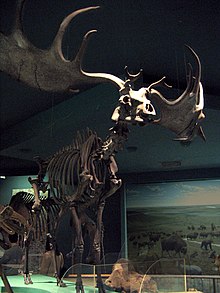Megaloceros
This article includes a list of references, related reading, or external links, but its sources remain unclear because it lacks inline citations. (April 2015) |
| Megaloceros Temporal range: Late Pliocene to Late Pleistocene,
| |
|---|---|

| |
| Scientific classification | |
| Kingdom: | |
| Phylum: | |
| Class: | |
| Order: | |
| Family: | |
| Genus: | Megaloceros
|
| Species | |
| |
| Synonyms | |
|
Megaceroides | |
Megaloceros (from Greek: μεγαλος, megalos + κερας, keras, literally "Great Horn"; see also Lister [1987]) is an extinct genus of deer whose members lived throughout Eurasia from the late Pliocene to the Late Pleistocene and were important herbivores during the Ice Ages. The largest species, Megaloceros giganteus, vernacularly known as the "Irish Elk" or "Giant elk", is also the best known.
Most members of the genus were extremely large animals that favoured meadows or open woodlands, with most species averaging slightly below 2 metres at the withers. Many of the Mediterranean species, on the other hand, were textbook examples of insular dwarfism, such as the Sardinian (and Corsican; the two were joined for much of the Pleistocene) M. cazioti, which was barely 1 metre tall. The various species of the Cretan genus Candiacervus – the smallest of which, C. rhopalophorus was just 65 cm high at the shoulder – are sometimes included in Megaloceros as a subgenus.

As the name "Irish Elk" implies[clarification needed], the larger species were somewhat similar in general habitus to the European Elk (Moose) and the American Elk. However, this has by now been shown to be a consequence of their increased size. The actual relationships are with the fallow deer genus Dama, and the genus was part of a Late Neogene Eurasian radiation of fallow deer relatives of which today only 2 taxa remain.(Lister et al. 2005, Hughes et al. 2006)
While most studies place all species in Megaloceros, sometimes the genus is considered more restricted in scope. In the most extreme case, it might be limited to M. antecedens and M. giganteus, the others being separated in Praemegaceros (European lineage) and Sinomegaceros (East Asian lineage). While the latter is probably valid as a subgenus, the former taxon requires more research as to its relationship with Megaloceros sensu stricto and Candiacervus in particular.
Species in chronological sequence
- M. obscurus
- Earliest known species from the Early Pleistocene of Europe. Had long, crooked antlers.
- M. luochuanensis
- M. verticornis
- Early to Mid-Pleistocene species, closely related to M. obscurus. Lived throughout Southern Europe. Suspected of being the ancestor of the Mediterranean species.
- M. antecedens
- Very similar to M. giganteus, to the point where it is often regarded as a paleosubspecies of the latter. The antlers were more compact, and the tines near the base large and palmate. Lived in Mid-Pleistocene Germany.
- M. pachyosteus
- Mid-Pleistocene China and Japan. Had long, curved antlers.
- M. savini
- Mid-Pleistocene species, slightly larger than a caribou, first fossils found near Sainte Savine, France. Its antlers were straight, with thorn-like prongs. The lowermost prongs near the base were palmate.
- M. cazioti
- Dwarf Mediterranean species from the Late Pleistocene of Sardinia and Corsica. About 1 metre at the shoulders, and is believed to be descended from M. verticornis. It survived until 5080 BCE.
- M. dawkinsi
- A Late Pleistocene species native to Great Britain, very similar to M. savini. The first human inhabitants of Britain may have encountered it, as some antler fragments have been found carved into crude tools.
- Largest, best known, and among the last species of the genus, about 2 metres at the shoulders. Lived throughout Eurasia, from Ireland to China during the last Ice Age.
References
- Hughes, Sandrine; Hayden, Thomas J.; Douady, Christophe J.; Tougard, Christelle; Germonpré, Mietje; Stuart, Anthony; Lbova, Lyudmila; Carden, Ruth F.; Hänni, Catherine; Say, Ludovic (2006): Molecular phylogeny of the extinct giant deer, Megaloceros giganteus. Molecular Phylogenetics and Evolution 40(1): 285–291. doi:10.1016/j.ympev.2006.02.004 PDF fulltext. Supplementary data 1, DOC fulltext Supplementary data 2, DOC fulltext Supplementary data 3, DOC fulltext
- Lister, A.M. (1987): Megaceros or Megaloceros? The nomenclature of the giant deer. Quaternary Newsletter 52: 14–16.
- Lister, A.M.; Edwards, C.J.; Nock, D.A.; Bunce, M.; van Pijlen, I.A.; Bradley, D.G.; Thomas, M.G. & Barnes, I. (2005): The phylogenetic position of the 'giant deer' Megaloceros giganteus. Nature PMID 16148942 doi:10.1038/nature04134 PDF fulltext Supplementary information
